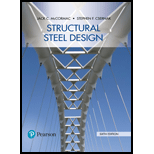
The selection of the lightest available W12 section to support the axial compression loads.
Answer to Problem 6.1PFS
W12 x 65
Explanation of Solution
Given data:
LRFD method:
The factored load is given by
Substituting the values,
Assume slenderness ratio as
From table 4-14 in the AISC manual,
Corresponding to yield stress,
The required area is
Substituting the values,
Try section
From table 1-1 in the AISC manual,
The properties of the trial section are
The slenderness ratio is
Substituting the values,
From table 4-14 in the AISC manual,
Corresponding to yield stress,
Corresponding to yield stress,
By interpolation, the critical stress for
The load-carrying capacity of the section is
Substituting the values,
The load-carrying capacity of the trial section
Try section
From table 1-1 in the AISC manual,
The properties of the trial section are
The slenderness ratio is
Substituting the values,
From table 4-14 in the AISC manual,
Corresponding to yield stress,
Corresponding to yield stress,
By interpolation, the critical stress for
The load-carrying capacity of the section is
Substituting the values,
The load-carrying capacity of the trial section
Therefore, use section
ASD method:
The factored load is given by
Substituting the values,
Assume slenderness ratio as
From table 4-14 in AISC manual,
Corresponding to yield stress,
The required area is
Substituting the values,
Try section
From table 1-1 in the AISC manual,
The properties of the trial section are
The slenderness ratio is
Substituting the values,
From table 4-14 in the AISC manual,
Corresponding to yield stress,
Corresponding to yield stress,
By interpolation, the critical stress for
The load-carrying capacity of the section is
Substituting the values,
The load-carrying capacity of the trial section
Try section
From table 1-1 in the AISC manual,
The properties of the trial section are
The slenderness ratio is
Substituting the values,
From table 4-14 in the AISC manual,
Corresponding to yield stress,
Corresponding to yield stress,
By interpolation, the critical stress for
The load-carrying capacity of the section is
Substituting the values,
The load-carrying capacity of the trial section
Therefore, use section
Conclusion:
Select the section
Want to see more full solutions like this?
Chapter 6 Solutions
Structural Steel Design (6th Edition)
- How can construction project managers find a balance between speeding up schedules and the risks of making more mistakes and needing rework, especially when using methods like fast tracking?arrow_forwardHelp i keep getting the wrong answer. So I must be doing something wrong.arrow_forwardwhat is the workhours earned to date for concrete footings?arrow_forward
- What is the budgeted unit work hours, in work hours per unit for the concrete walls?arrow_forwardWhat are the total earned work hours at completion for the column forms?arrow_forward6000 units have been installed to date with 9,000 units to install. Labor costs are $23,300.00 to date. What is the unit cost for labor to date?arrow_forward
- The base rate for labor is $15/hr. The labor burden is 35% and 3% for small tools for the labor. There are 1000 units to install. Records indicate that trade workers can install 10 units per hour, per trade worker. The owners need 15% overhead and profit to pay bills, pay interest on loan and provide some profit to the partners. What is the minimum bid assuming no risk avoidance factor?arrow_forwardCan you show me how to obtain these answers thanks, will rate!arrow_forwardI have the answers for part a just need help with b mostly thanksarrow_forward
- Please explain step by step and show formulasarrow_forward5. (20 Points) Consider a channel width change in the same 7-foot wide rectangular in Problem 4. The horizontal channel narrows as depicted below. The flow rate is 90 cfs, and the energy loss (headloss) through the transition is 0.05 feet. The water depth at the entrance to the transition is initially 4'. 1 b₁ TOTAL ENERGY LINE V² 129 У1 I b₂ TOP VIEW 2 PROFILE VIEW h₁ = 0.05 EGL Y₂ = ? a) b) c) 2 Determine the width, b₂ that will cause a choke at location 2. Determine the water depth at the downstream end of the channel transition (y₂) section if b₂ = 5 feet. Calculate the change in water level after the transition. Plot the specific energy diagram showing all key points. Provide printout in homework. d) What will occur if b₂ = = 1.5 ft.?arrow_forward4. (20 Points) A transition section has been proposed to raise the bed level a height Dz in a 7-foot wide rectangular channel. The design flow rate in the channel is 90 cfs, and the energy loss (headloss) through the transition is 0.05 feet. The water depth at the entrance to the transition section is initially 4 feet. b₁ = b = b2 1 TOTAL ENERGY LINE V² 129 Ут TOP VIEW 2 hloss = 0.05 " EGL Y₂ = ? PROFILE VIEW a) Determine the minimum bed level rise, Dz, which will choke the flow. b) If the step height, Dz = 1 ft, determine the water depth (y2) at the downstream end of the channel transition section. Calculate the amount the water level drops or rises over the step. c) Plot the specific energy diagram showing all key points. Provide printout in Bework. d) What will occur if Dz = 3.0 ft.?. Crest Front Viewarrow_forward
 Steel Design (Activate Learning with these NEW ti...Civil EngineeringISBN:9781337094740Author:Segui, William T.Publisher:Cengage Learning
Steel Design (Activate Learning with these NEW ti...Civil EngineeringISBN:9781337094740Author:Segui, William T.Publisher:Cengage Learning Materials Science And Engineering PropertiesCivil EngineeringISBN:9781111988609Author:Charles GilmorePublisher:Cengage Learning
Materials Science And Engineering PropertiesCivil EngineeringISBN:9781111988609Author:Charles GilmorePublisher:Cengage Learning

